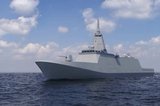Thales UK signs Royal Navy sensor support contract
Thales UK will provide in-service support of the Royal Navy’s major sensor systems under a new contract with the UK Ministry of Defence (MoD) signed on 28 May. The ten year contract is worth up to £600 million, and is part of the new Sensors Support Optimisation Project (SSOP).
The SSOP builds on the success of Thales’s Contractor Logistics Support contract, originally signed in 2003, which has provided support to the Royal Navy’s sonar and electronic warfare systems for the past ten years.
Under the terms of SSOP, the in-service support contract has now been extended to include all of the Royal Navy’s submarine visual systems, including periscopes for the Vanguard and Trafalgar Class submarines and the non-hull-penetrating optronic masts for the Astute Class submarines, previously supported under separate contract arrangements with Thales UK’s optronics business in Glasgow.
The contract will see Thales provide in-service support to the ‘eyes and ears’ of the submarine fleet, as well as across the major surface sonar and electronic warfare systems. The work will be run through the joint MoD/Thales UK Equipment Support Delivery Team based in Abbey Wood, Bristol, and will be augmented by a number of specialist waterfront engineers.
Philip Dunne, Minister for Defence Equipment, Support and Technology, said: ‘This contract is good news for the MoD and UK industry. Not only will it secure a number of jobs across the UK whilst delivering savings but will also provide essential support for the combat equipment that helps give the Royal Navy’s fleet of ships and submarines a vital technological edge wherever they are based in the world.’
Victor Chavez, CEO, Thales UK, added: ‘This contract recognises the value that can be achieved and the savings that can be delivered through a long-term services agreement. It also reflects the successful way in which Thales UK has delivered the required outputs over the past ten years. This project refines that approach to optimise performance over the next ten years, and reinforces our positive well-established relationship with the Royal Navy.’
More from Naval Warfare
-
![Mitsubishi eyes future with Australia’s Mogami selection]()
Mitsubishi eyes future with Australia’s Mogami selection
With Australia’s selection of the Mogami-class for Project Sea 3000, Mitsubishi is investigating local production in the next decade as potential export opportunities emerge.
-
![Thales’ new Sonar 76Nano could equip UK Royal Navy on anti-submarine warfare missions]()
Thales’ new Sonar 76Nano could equip UK Royal Navy on anti-submarine warfare missions
The new sonar is designed to equip uncrewed underwater vessels, with the potential to be used by the Royal Navy for its Atlantic Bastion and Atlantic Net missions.
-
![Hanwha wins Australian government approval to increase its stake in Austal]()
Hanwha wins Australian government approval to increase its stake in Austal
The contract would mean the two shipbuilders can collaborate strategically and enhance shipbuilding capabilities in Western Australia.






















